Have you noticed your cat’s affinity for scratching? Perhaps it's your sofa or the lovely drapes that are at the receiving end of those sharp claws. Maybe it's time to consider a scratching post for your feline friend. And guess what? You can make one yourself, right at home! We'll guide you on how to make a scratching post from a log.
In this article, we will explain how to create a DIY scratching post. We will walk you through the process, from preparing your materials to positioning the post in your home. And we’ll answer some common questions. Is wood the right material? What should you use to wrap around the log?
Stay tuned and get ready to engage in a fun DIY project that not only benefits your cat but also saves your precious furniture. So, let's dive right in!
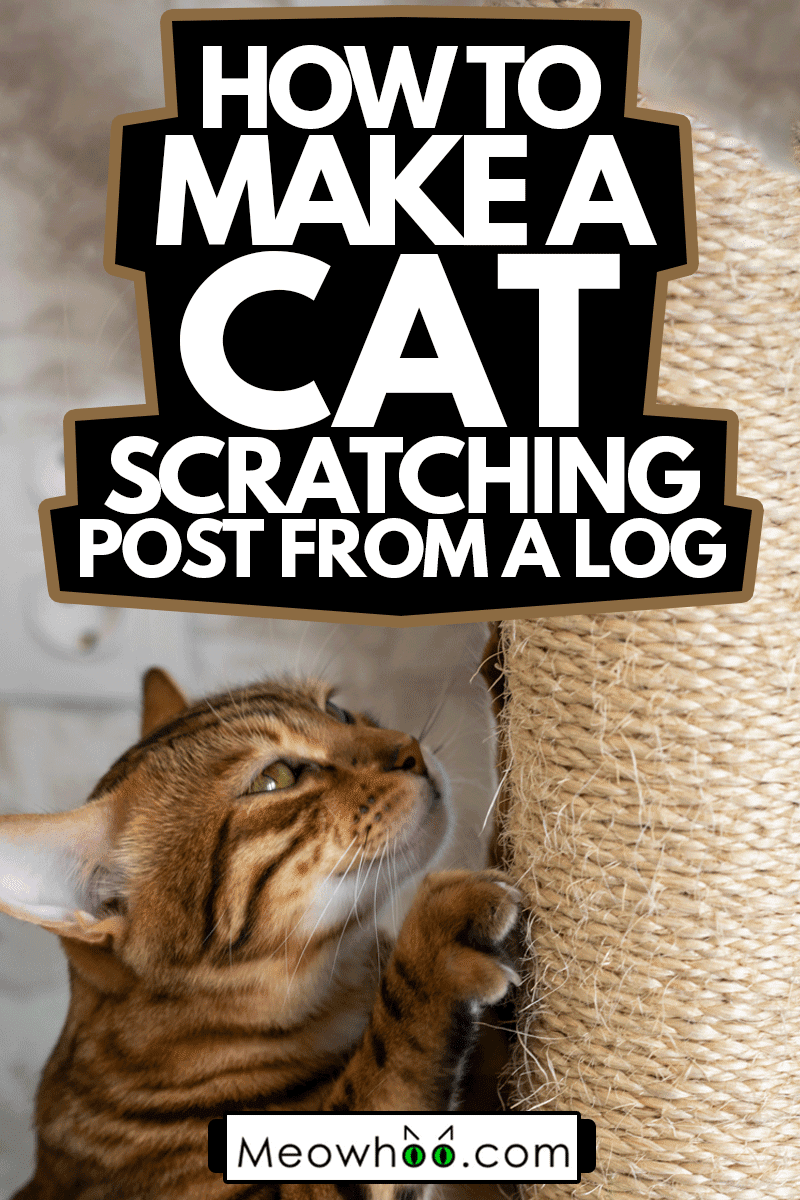
The Battle Against Furniture Destruction: DIY Scratching Post
Ever noticed how your cat has an irresistible urge to stretch and sharpen their claws? Unfortunately, this often results in claw marks on your beloved furniture or exquisite drapes. A scratching post can be a fantastic solution to divert this natural behavior away from your furnishings, and creating one might be easier than you think!
With a log, some plywood, and a dash of DIY spirit, you can craft a scratching post that your cat will love. The steps are quite straightforward:
- Get your materials ready.
- Cut your log and plywood base to the right dimensions.
- Adorn the log with either a rope or fabric.
- Cover the base of the post with fabric.
- Securely fasten the log to the base.
- Position the scratching post in a convenient location for your cat.
The process of making a scratching post naturally brings up a few queries. Is wood an appropriate choice for the post? What materials are most suitable for wrapping around the log? Keep reading, and we'll answer these questions and more!
Creating A Cat Scratching Post Using A Log
To create a scratching post from a log for your feline pets, follow these detailed steps:
1. Prepare Your Materials
For this project, you will need a log made of hardwood such as oak, maple, or redwood. You can use plywood for the base of the scratching post.
You will also need rope or fabric. Sisal rope, cotton rope, or woven sisal fabric would do well for scratching posts.
The rope should be at least 50 feet in length to ensure that it wraps around the entirety of the log. If you decide to use fabric, you should make sure that it is long enough to embrace the log without any gaps.
You will also need a saw, a staple gun, and an electric drill (or a screwdriver with bits and driver heads). You will also need eye and ear protection when you work with the saw and drill.
2. Cut The Wood To The Right Size
Using a measuring tape, you should measure your cat from the tip of its nose to the base of its tail. This measurement will allow you to find the optimal size for your scratching post.
The log should have at least 2 inches in diameter and at least 31 inches tall. This size allows your cat to stretch completely and scratch as comfortably as possible.
To learn more about the optimal height of your cat’s scratching post, check out this helpful article: How Tall Should A Cat Scratching Post Be?
For the base of the scratching post, you will need a piece of plywood. The base should be square around a foot long on each side so that the log can stay stable and upright.
You can cut the log and the plywood to size by using a saw. It would be best to sand any rough edges to prevent hurting you or your pet.
Afterward, mark a line on the plywood from corner to corner. You can then mark two drill areas depending on the diameter of your log.
3. Wrap A Rope Or Fabric To The Log
Grab one end of the rope and vertically staple it at the bottom of the log. Vertical staples are necessary to avoid catching your cat’s claw, which could get its claw stuck and injure your cat.
Wrap the rope around as tightly as you can. Continue wrapping until you leave at least 6 inches at the top of the log.
Using a woven sisal fabric is easier since all you have to do is wrap the fabric around the log. Once you wrap it around once, you can staple the ends vertically and trim off the excess.
4. Add Fabric To The Base
Cats enjoy vertical and horizontal scratching posts. As such, it would help if you also add fabric to the base of your scratching post.
You can simply stretch a piece of an old carpet or woven sisal fabric over the board. Afterward, staple the edges to the bottom of the base.
5. Attach The Log To The Base
Now that both the log and base are ready, you can now attach them. Drill a hole in the areas you have marked on the bottom.
Afterward, you can place the base over the log and drill pilot holes. Once the holes are made, you can use the drill or a screwdriver to attach them until the log is secured.
6. Place The Log For Your Cat’s Use
Now that the scratching post is ready, you can place it in a prominent area in your home where your cat can easily access it.
Cats love to scratch after a nap, so the best place to put the scratching post is next to your cat’s favorite napping spot.
Different cats use their scratchers at different times. To find out more about when your cat scratches and where you should put your scratcher, check out this post: How Often Do Cats Use The Scratching Post?
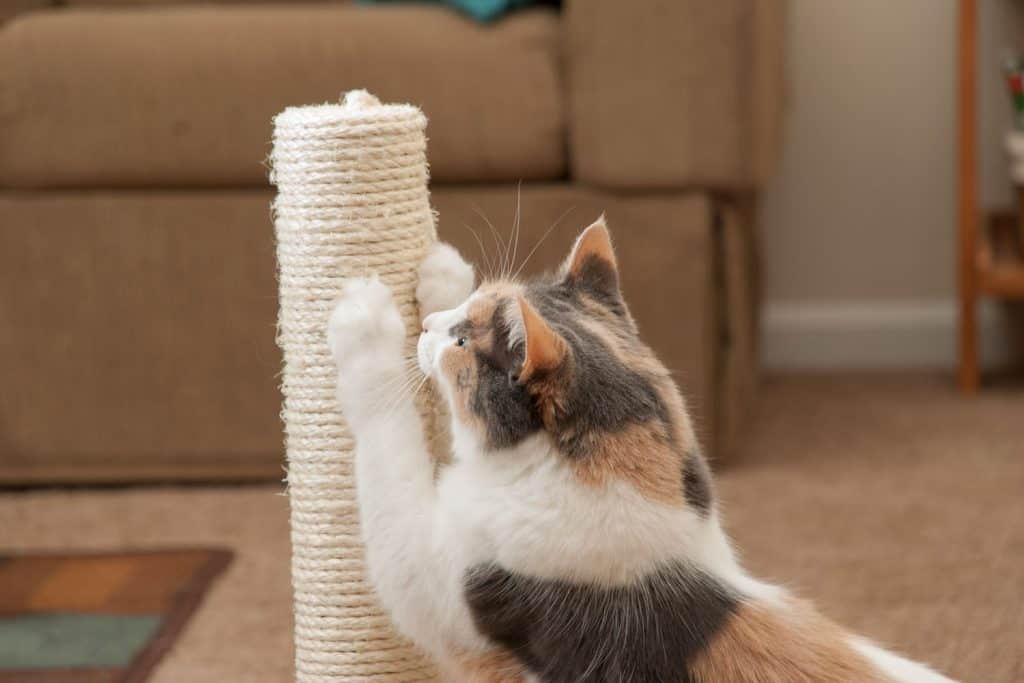
Can Cats Use Wood As A Scratching Post?
Yes, wood is a good material for cats to use as scratching posts. In the wild, cats use tree bark as natural scratching material, so wooden posts are not so different.
Wood is an excellent natural scratching material for cats because it is durable and long-lasting.
What Is The Rope On Cat Scratching Post?
The rope used on most scratching posts is made of sisal fibers. Sisal ropes are wonderful scratching materials because they are durable and allow cats to sharpen their claws without hurting them.
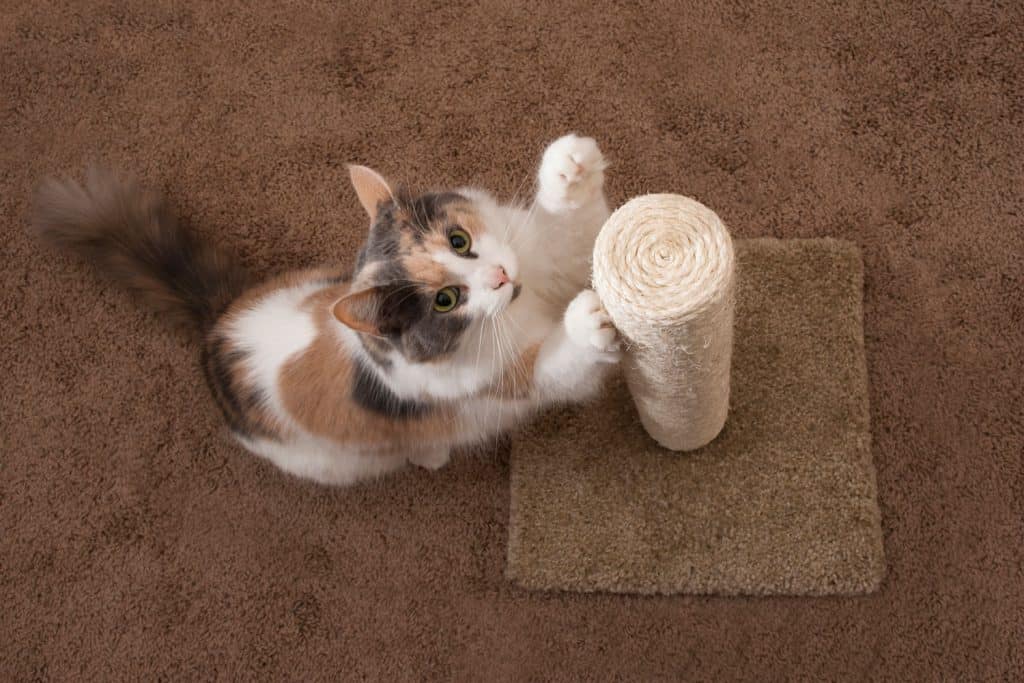
What Is The Best Material To Use For A Cat Scratching Post?
Cats scratch to stretch their body and maintain their nails. And so, they require scratching posts of good length made from solid and stable materials.
Aside from wood, the following materials are great options for your cat’s scratching posts and mats:
Sisal
Excellent material to use is rope and fabric. Sisal ropes are durable and incredibly satisfying for cats to scratch on.
Sisal ropes are resistant to wear and tear, which contributes to their longevity. Sisal ropes also do not look dull and are worn even after consistent use.
Although resistant to damage, sisal ropes will eventually fray. When it begins to fray, sisal ropes become sharp and uncomfortable for cats to scratch on. This discomfort may dissuade your cat from ever using it again and will look for other alternatives such as your couch.
To prevent this, you can opt for woven sisal scratching posts. Woven sisal fabrics are more resistant to shredding and damage compared to their rope counterpart.
Cardboard
Cardboard is an inexpensive alternative to wood and other high-quality scratching posts. You can buy cardboard from most local stores and get them through deliveries.
Cats love cardboard because of the feel and sound that they make when scratched.
The downside to cardboard is that it shreds quickly. Cats love scratching on cardboard, so you can expect to find bits and pieces around your home every time your cats use it.
Carpet
Albeit a more expensive option, carpet and other durable fabrics are great scratching materials for cats.
If you do decide to use carpets as scratching materials, you should opt for cut fiber carpets because shaggy rugs are highly susceptible to wear and tear.
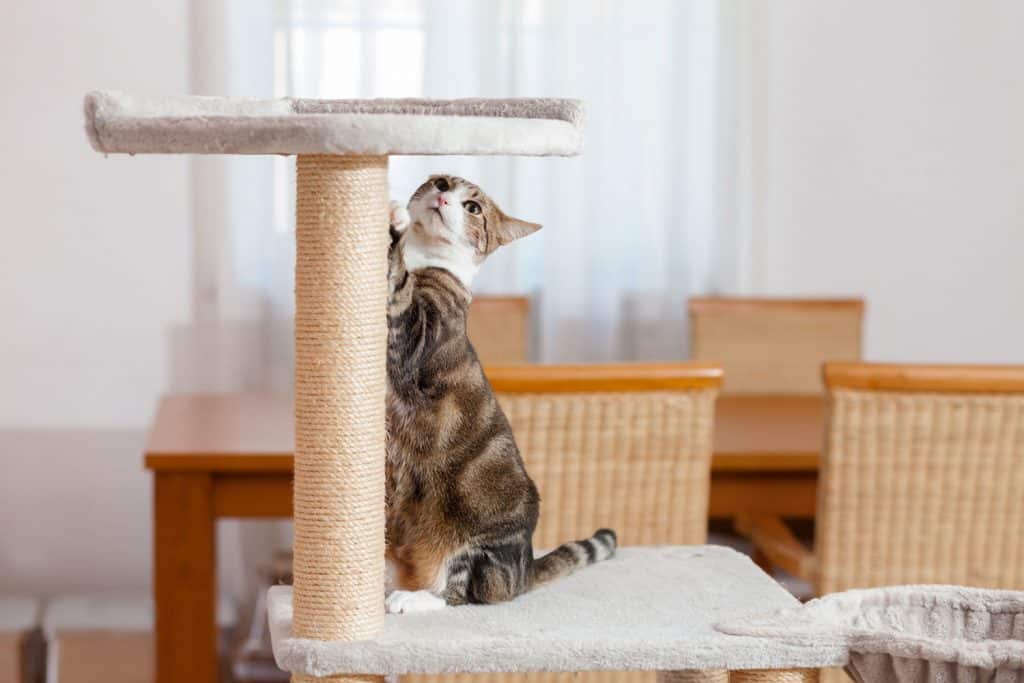
Can I Use Cotton Rope For A Cat Scratching Post?
Yes, you can use cotton rope for a cat scratching post. Cotton rope is soft and biodegradable, so it can be used around animals without posing any danger to their health.
Although cotton ropes are primarily decorative, you can use braided cotton ropes instead of traditional coiled ones. Braided cotton ropes are more robust and longer-lasting compared to regular cotton ropes.
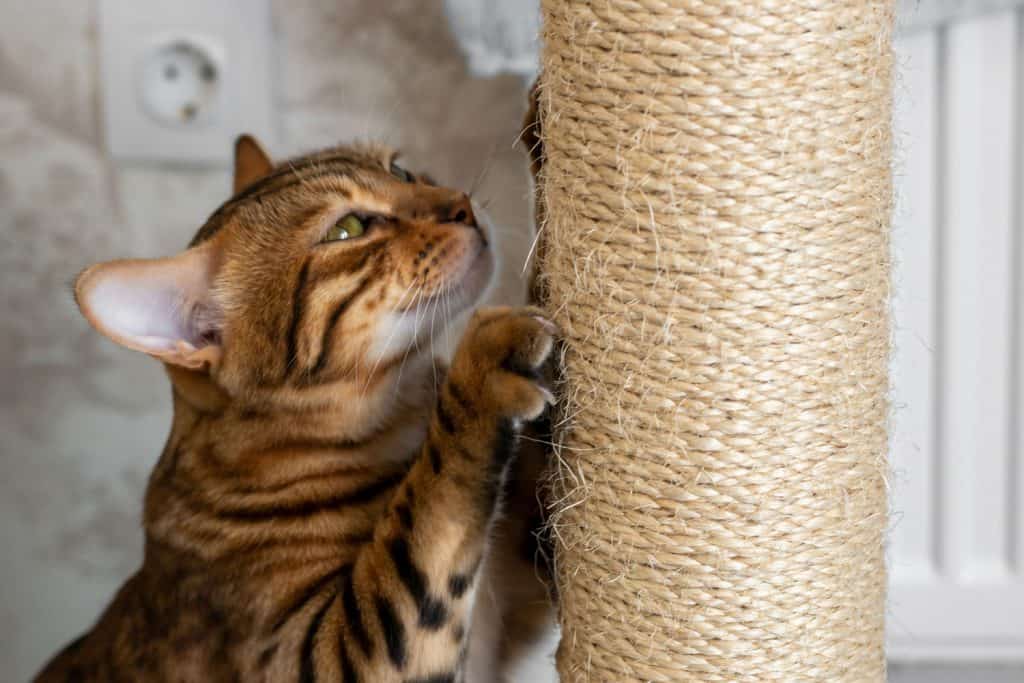
Homemade Scratching Posts for Stress Relief and Furniture Protection
Scratching posts are a great way to relieve a cat’s tension by allowing them to satisfy their instinct to stretch and maintain their claws. To meet their needs, you can create a scratching post using materials in your home.
By following six simple steps, you can help your cat fulfill its innate desire to scratch while protecting your beloved furniture from damage.
Some elements on this page may have been created by our team using advanced AI to provide you with top-notch cat inspired ideas. Read more about our AI Content Policy.
